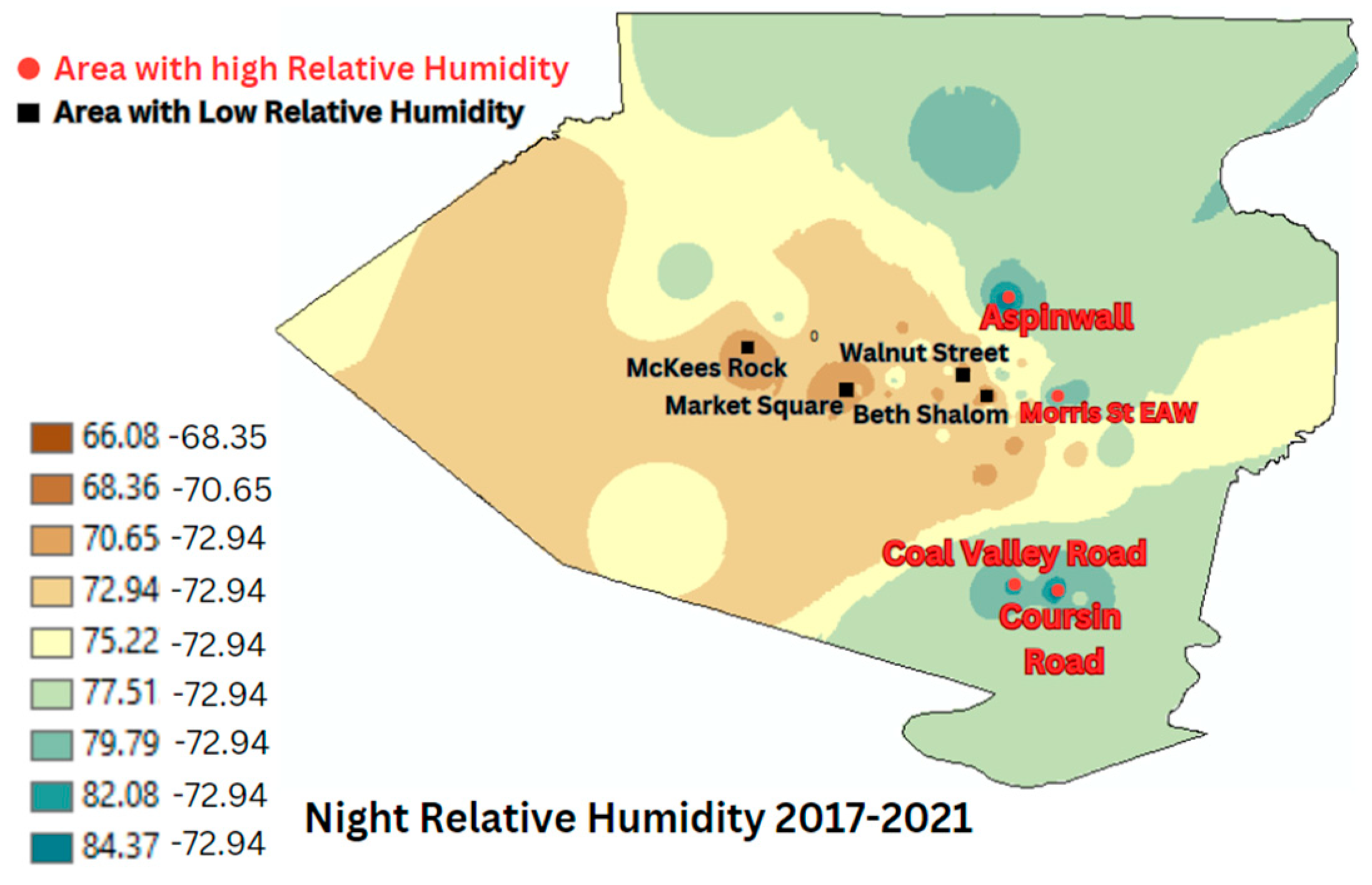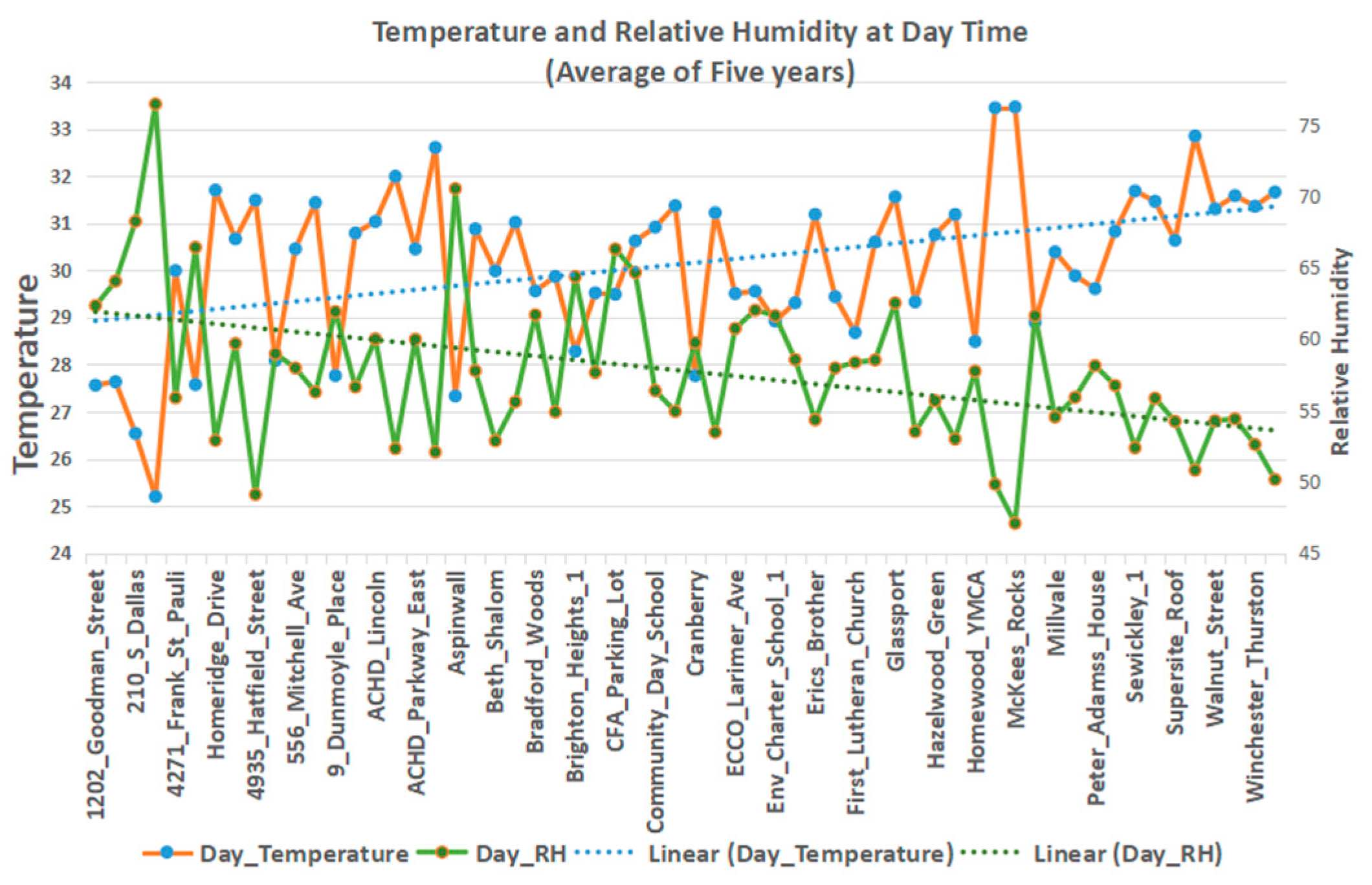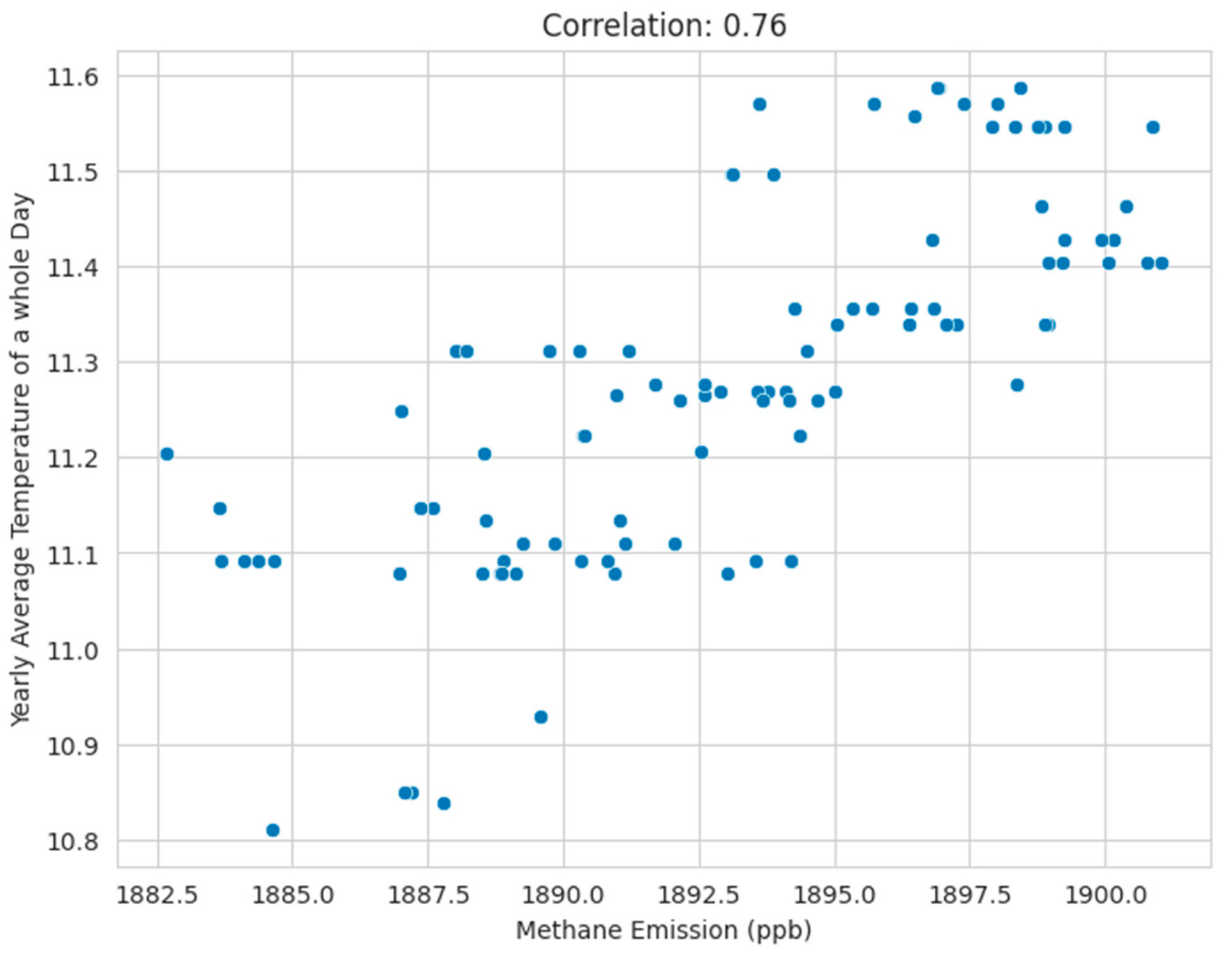Analyzing Temperature Variations in Different Locations within Allegheny County and Its Surrounding Area: The Influence of Methane Emission and the Relationship with Relative Humidity †
Abstract
:1. Introduction
2. Methods
2.1. Data
2.2. Study Period and Study Area Selection
2.3. Anomaly Detection
2.4. Simulation by ArcMap
2.5. Collection of Methane Emission Data
3. Results and Discussion
3.1. Data Analysis
3.2. Excessively High or Low Temperature in Certain Locations during Daytime
3.3. Excessively High or Low Temperature during Night
3.4. Excessively High or Low Relative Humidity during Day
3.5. Excessively High or Low Relative Humidity during Night
3.6. Relation of Relative Humidity with Temperature
3.7. Methane Emission
3.8. Relation of Temperature with Methane Emission
4. Conclusions
Author Contributions
Funding
Institutional Review Board Statement
Informed Consent Statement
Data Availability Statement
Acknowledgments
Conflicts of Interest
References
- Burnett, C.; Blaschke, T. A multi-scale segmentation/object relationship modelling methodology for landscape analysis. Ecol. Modell. 2003, 168, 233–249. [Google Scholar] [CrossRef]
- Yang, L.; Qian, F.; Song, D.X.; Zheng, K.J. Research on urban heat-island effect. Procedia Eng. 2016, 169, 11–18. [Google Scholar] [CrossRef]
- Ferrante, A.; Mariani, L. Agronomic Management for Enhancing Plant Tolerance to Abiotic Stresses: High and Low Values of Temperature, Light Intensity, and Relative Humidity. Horticulturae 2018, 4, 21. [Google Scholar] [CrossRef]
- Howarth, R.W. A bridge to nowhere: Methane emissions and the greenhouse gas footprint of natural gas. Energy Sci. Eng. 2014, 2, 47–60. [Google Scholar] [CrossRef]
- Lamb, B.K.; McManus, J.B.; Shorter, J.H.; Kolb, C.E.; Mosher, B.; Harriss, R.C.; Zimmerman, P. Development of atmospheric tracer methods to measure methane emissions from natural gas facilities and urban areas. Environ. Sci. Technol. 1995, 29, 1468–1479. [Google Scholar] [CrossRef] [PubMed]
- Beck, M.R.; Thompson, L.R.; Rowntree, J.E.; Campbell, T.N.; Koziel, J.A.; Place, S.E.; Stackhouse-Lawson, K.R. US manure methane emissions represent a greater contributor to implied climate warming than enteric methane emissions using the global warming potential* methodology. Front. Sustain. Food Syst. 2023, 7, 1209541. [Google Scholar] [CrossRef]
- Sarda, R.; Pal, S. Nexus Between Anthropogenic Heat Flux and Urban Heat Island. In Advancements in Urban Environmental Studies: Application of Geospatial Technology and Artificial Intelligence in Urban Studies; Springer International Publishing: Cham, Switzerland, 2023; pp. 301–324. [Google Scholar]
- Gorelick, N. Google Earth Engine: Planetary-scale geospatial analysis for everyone. Remote Sens. Environ. 2017, 202, 18–27. [Google Scholar] [CrossRef]
- Samariya, D.; Thakkar, A. A Comprehensive Survey of Anomaly Detection Algorithms. Ann. Data Sci. 2023, 10, 829–850. [Google Scholar] [CrossRef]
- Vineesha, S. Estimating land surface temperature in ArcGIS using Landsat-8, Hoshangabad district, (Madhya Pradesh). Int. J. Appl. Res. 2017, 3, 1374–1379. [Google Scholar]
- Hernández-Hamón, H.; Ramírez, P.Z.; Zaraza, M.; Micallef, A. Google Earth Engine app using Sentinel 1 SAR and deep learning for ocean seep methane detection and monitoring. Remote Sens. Appl. Soc. Environ. 2023, 32, 101036. [Google Scholar] [CrossRef]
- European Commission. Available online: https://energy.ec.europa.eu/newsletters_en (accessed on 20 October 2023).
- Methane–Density–Heat Capacity–Thermal Conductivity. Available online: https://material-properties.org/methane-density-heat-capacity-thermal-conductivity/?fbclid=IwAR3MrFAHMWZJgFwLgDA6Q9ngsGsQXPEYUhjs4i5Xze8bzbB-KYfcPc4cd_k (accessed on 20 October 2023).








Disclaimer/Publisher’s Note: The statements, opinions and data contained in all publications are solely those of the individual author(s) and contributor(s) and not of MDPI and/or the editor(s). MDPI and/or the editor(s) disclaim responsibility for any injury to people or property resulting from any ideas, methods, instructions or products referred to in the content. |
© 2023 by the authors. Licensee MDPI, Basel, Switzerland. This article is an open access article distributed under the terms and conditions of the Creative Commons Attribution (CC BY) license (https://creativecommons.org/licenses/by/4.0/).
Share and Cite
Afzal, L.; Shaon, F.H.; Mannan, R. Analyzing Temperature Variations in Different Locations within Allegheny County and Its Surrounding Area: The Influence of Methane Emission and the Relationship with Relative Humidity. Eng. Proc. 2023, 56, 266. https://doi.org/10.3390/ASEC2023-15337
Afzal L, Shaon FH, Mannan R. Analyzing Temperature Variations in Different Locations within Allegheny County and Its Surrounding Area: The Influence of Methane Emission and the Relationship with Relative Humidity. Engineering Proceedings. 2023; 56(1):266. https://doi.org/10.3390/ASEC2023-15337
Chicago/Turabian StyleAfzal, Lubaba, Fuad Hassan Shaon, and Raiyan Mannan. 2023. "Analyzing Temperature Variations in Different Locations within Allegheny County and Its Surrounding Area: The Influence of Methane Emission and the Relationship with Relative Humidity" Engineering Proceedings 56, no. 1: 266. https://doi.org/10.3390/ASEC2023-15337
APA StyleAfzal, L., Shaon, F. H., & Mannan, R. (2023). Analyzing Temperature Variations in Different Locations within Allegheny County and Its Surrounding Area: The Influence of Methane Emission and the Relationship with Relative Humidity. Engineering Proceedings, 56(1), 266. https://doi.org/10.3390/ASEC2023-15337





